【步步登高】2014年高考英语总复习专项专题课件:主谓一致(39ppt,含2013试题)
文档属性
| 名称 | 【步步登高】2014年高考英语总复习专项专题课件:主谓一致(39ppt,含2013试题) |  | |
| 格式 | zip | ||
| 文件大小 | 660.8KB | ||
| 资源类型 | 教案 | ||
| 版本资源 | 通用版 | ||
| 科目 | 英语 | ||
| 更新时间 | 2013-09-23 22:43:24 | ||
图片预览

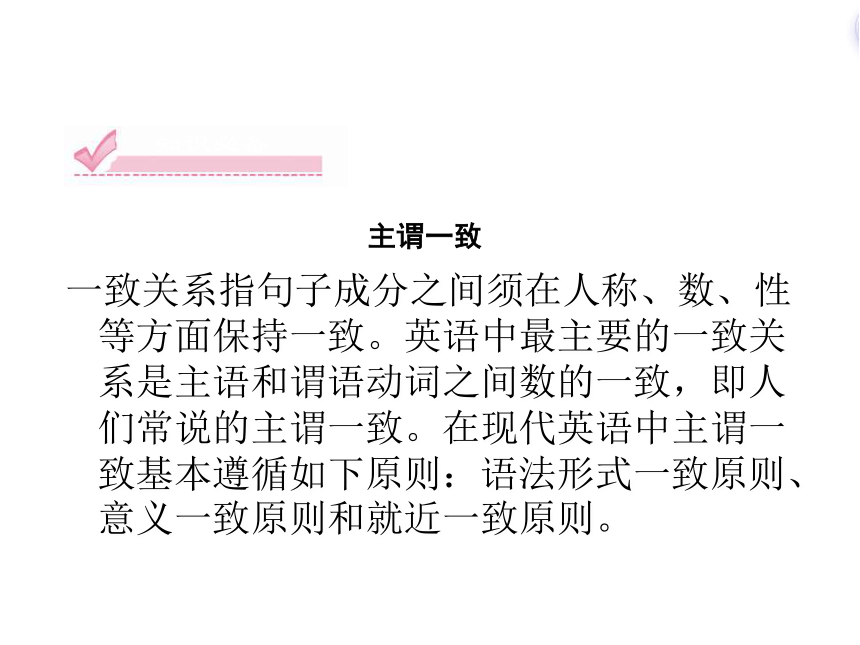
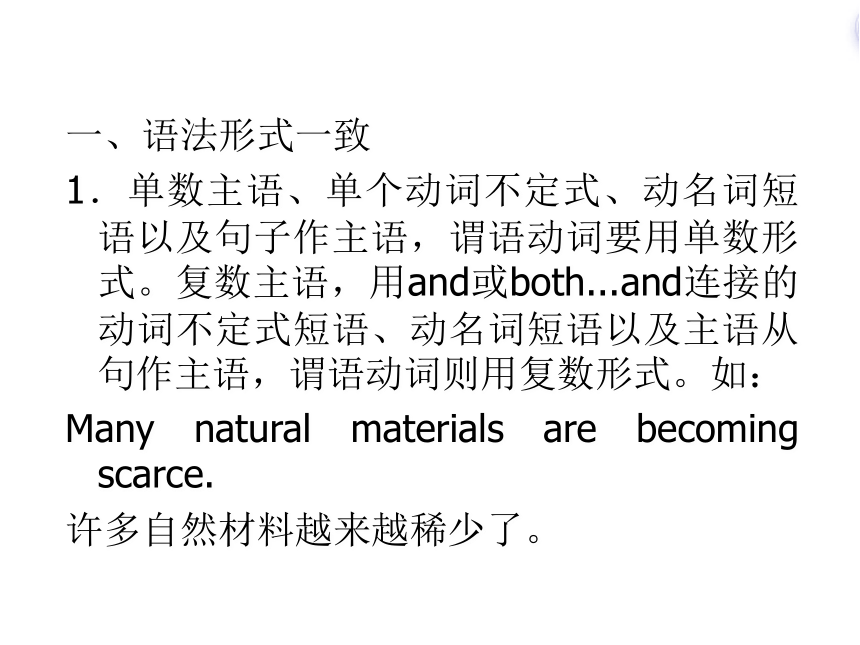

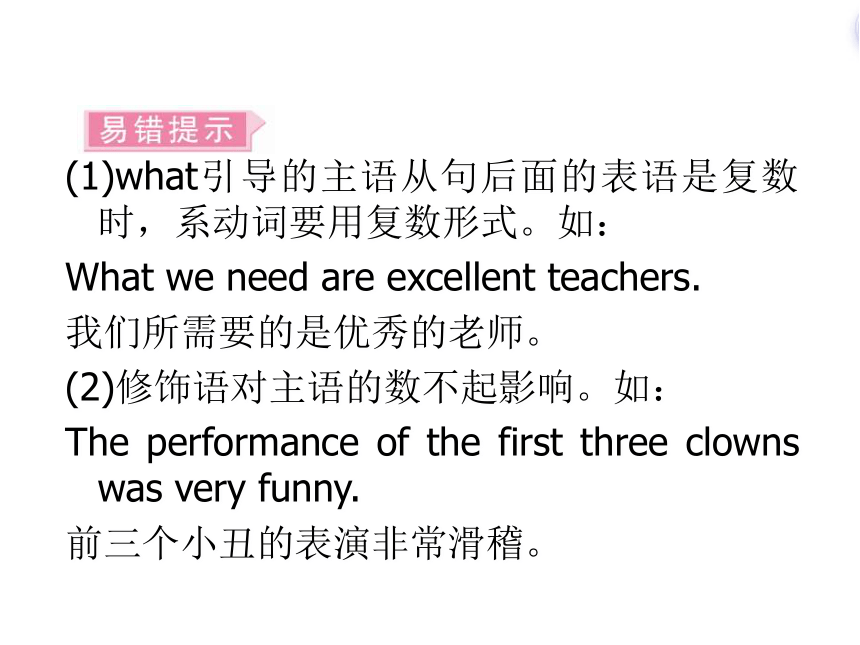
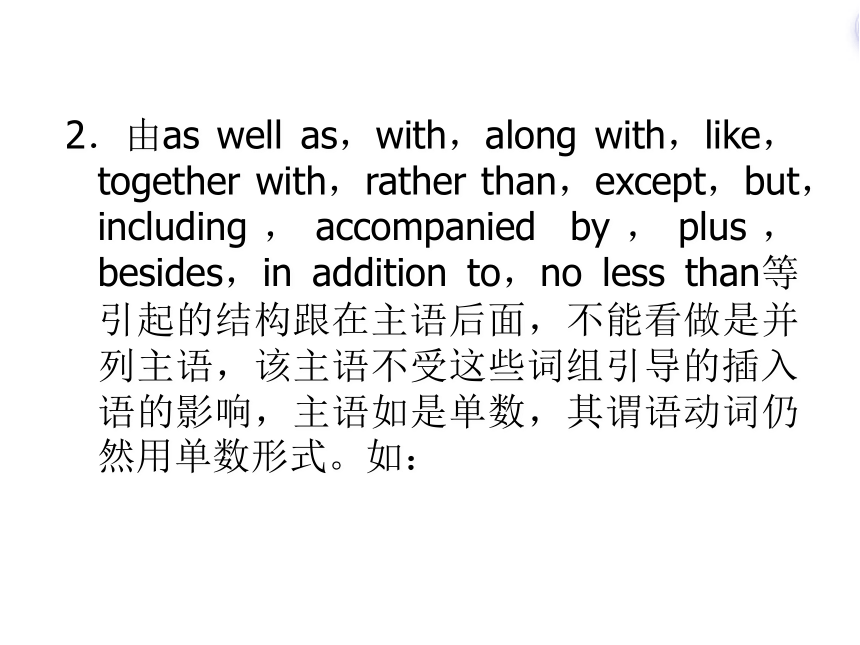

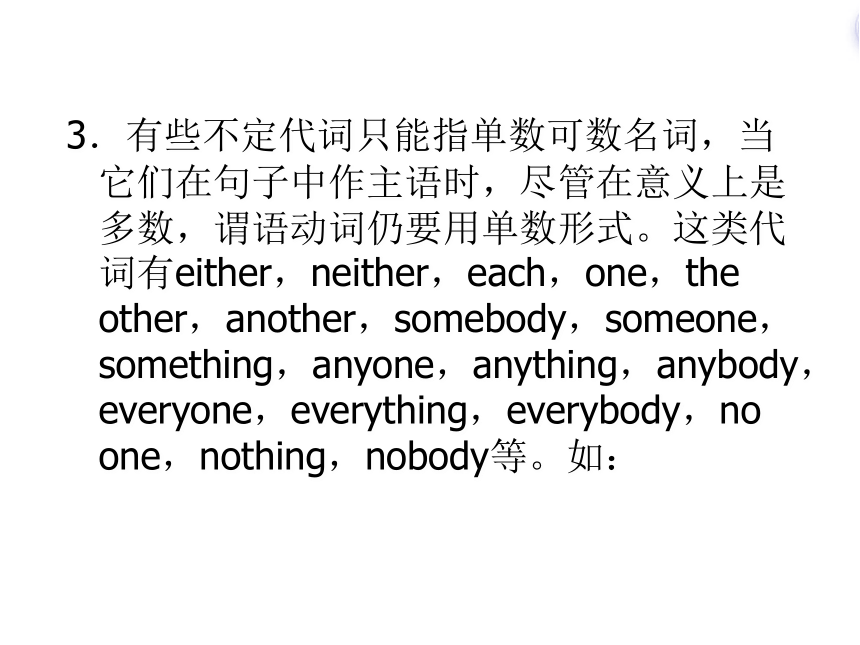

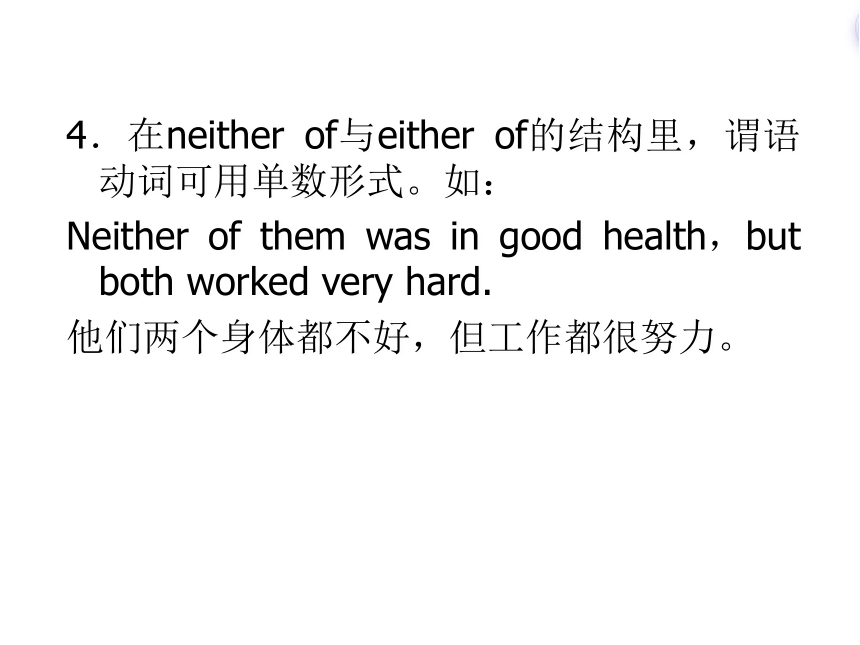
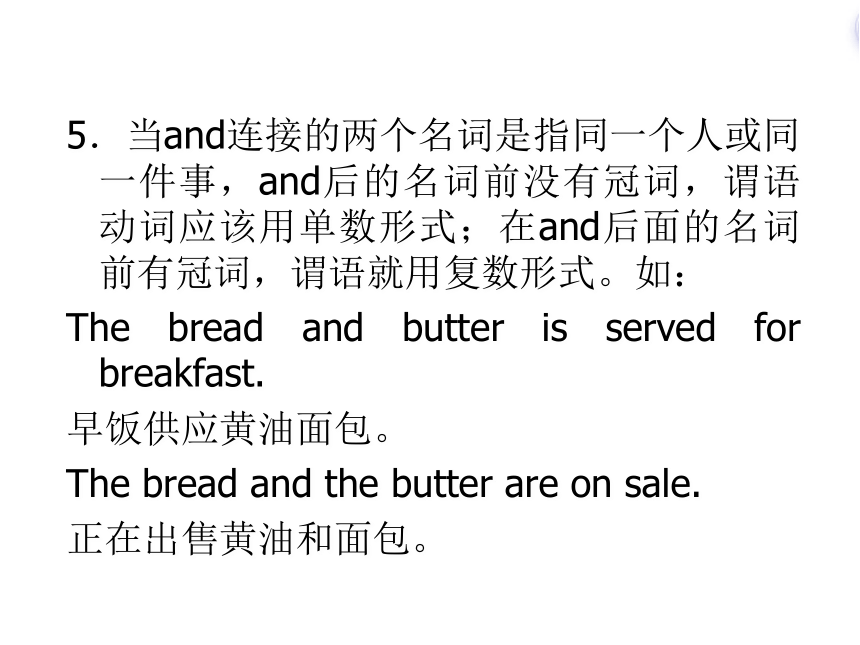
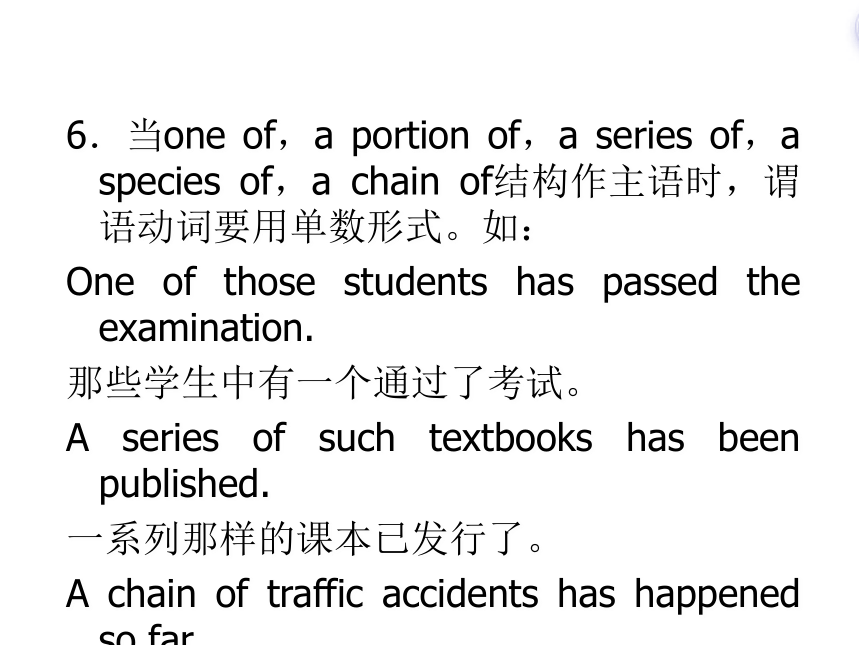
文档简介
(共40张PPT)
语法专项突破
语法专项十四 主谓一致
一致关系指句子成分之间须在人称、数、性等方面保持一致。英语中最主要的一致关系是主语和谓语动词之间数的一致,即人们常说的主谓一致。在现代英语中主谓一致基本遵循如下原则:语法形式一致原则、意义一致原则和就近一致原则。
知识必备
主谓一致
一、语法形式一致
1.单数主语、单个动词不定式、动名词短语以及句子作主语,谓语动词要用单数形式。复数主语,用and或both...and连接的动词不定式短语、动名词短语以及主语从句作主语,谓语动词则用复数形式。如:
Many natural materials are becoming scarce.
许多自然材料越来越稀少了。
Serving the people is my great happiness.
为人民服务是我最幸福的事。
Whether we'll go depends on the weather.
我们是否去取决于天气。
What I think and what I seek have been fairly reflected in my paper.
我的想法与我的追求在我的论文中得到了反映。
(1)what引导的主语从句后面的表语是复数时,系动词要用复数形式。如:
What we need are excellent teachers.
我们所需要的是优秀的老师。
(2)修饰语对主语的数不起影响。如:
The performance of the first three clowns was very funny.
前三个小丑的表演非常滑稽。
2.由as well as,with,along with,like,together with,rather than,except,but,including,accompanied by,plus,besides,in addition to,no less than等引起的结构跟在主语后面,不能看做是并列主语,该主语不受这些词组引导的插入语的影响,主语如是单数,其谓语动词仍然用单数形式。如:
My mother,as well as my father,has a key to the office.
不仅是我的爸爸,我妈妈也有办公室的钥匙。
The man together with his wife and children sits there watching TV.
这个男子与他的妻子和孩子们一起坐着看电视。
3.有些不定代词只能指单数可数名词,当它们在句子中作主语时,尽管在意义上是多数,谓语动词仍要用单数形式。这类代词有either,neither,each,one,the other,another,somebody,someone,something,anyone,anything,anybody,everyone,everything,everybody,no one,nothing,nobody等。如:
Neither likes the friends of the other.
两人都不喜欢对方的朋友。
Everything around us is matter.
我们周围的所有东西都是物质。
4.在neither of与either of的结构里,谓语动词可用单数形式。如:
Neither of them was in good health,but both worked very hard.
他们两个身体都不好,但工作都很努力。
5.当and连接的两个名词是指同一个人或同一件事,and后的名词前没有冠词,谓语动词应该用单数形式;在and后面的名词前有冠词,谓语就用复数形式。如:
The bread and butter is served for breakfast.
早饭供应黄油面包。
The bread and the butter are on sale.
正在出售黄油和面包。
6.当one of,a portion of,a series of,a species of,a chain of结构作主语时,谓语动词要用单数形式。如:
One of those students has passed the examination.
那些学生中有一个通过了考试。
A series of such textbooks has been published.
一系列那样的课本已发行了。
A chain of traffic accidents has happened so far.
到目前为止发生了一连串的交通事故。
7.form of,type of,kind of结构的谓语视form,type与kind的单复数而定。these/those kinds/types of后是复数名词,谓语动词用复数形式。如:
The kind of books isn't suitable for children.这种书不适合孩子阅读。
Some new types of cars are now on show.现在,有些新型汽车在展示中。
These kinds of recorders are good.这些种类的录音机不错。
8.由“one and a half+复数名词”作主语时,谓语动词用单数。但是,“one or two+复数名词”作主语时,谓语动词用复数形式。如:
One and a half apples is left on the plate.
盘子里剩下一个半苹果。
One or two students were late for classes every day.
每天都会有一两个学生上课迟到。
9.由“the majority of+名词”作主语时,谓语动词视名词的单复数形式而定。如:
The majority of the damage is easy to repair.
大部分损坏的地方修理起来比较容易。
The majority of criminals are non violent.
大多数罪犯都是非暴力的。
10.plenty of,half of,a lot of,lots of,heaps of,loads of等+可数与不可数名词作主语时,不可数名词的谓语只用单数,可数名词的谓语视可数名词的单复数而定。如:
Half of this building is to be completed by spring.
到春季我们将会完成一半的建筑工程。
Half of the buildings have been painted completely.
这些建筑物中有一半被完全粉刷了。
There is plenty of water in the pail.
水桶中有足够的水。
There are plenty of eggs in the box.
箱子中有足够的鸡蛋。
11.由all of,most of,a lot of,some of,plenty of,the rest of,none of等+名词作主语时,谓语动词的单复数形式应与名词一致。如:
All of the research work was designed by the chief engineer.
所有的研究工作都是由总工程师设计的。
All of the students are against the plan for an outing at this time of the term.
所有的学生都反对在学期的这个时候去旅行的计划。
Noneof the books satisfy the students.
这些书中没有一本使学生感到满意。
None of this meat is fit to eat.
这肉没有一点儿能吃的。
12.由more than one(或more than one+单数名词),many a+单数名词作主语,谓语动词要用单数形式。如:
More than one student has passed the examination.
不止一位学生通过了考试。
Many a boy learns to swim before he can read.
许多男孩在学会读书前就会游泳了。
13.“amounts of/quantities of+复数名词或不可数名词”后接复数动词。
“a quantity of+复数名词”后接复数动词。
“a quantity of+不可数名词”和“an amount of+不可数名词”后接单数动词。
“a number of+复数名词”后跟复数动词;“the number of+复数名词”后跟单数动词。
Great quantities of milk are needed in this city.
这座城市需要大量的牛奶。
There is a large quantity of milk.
有大量的牛奶。
A large amount of time has been wasted.
浪费了大量的时间。
A large number of students are going to take part time jobs during summer holidays.
有大量的学生在暑假期间做临时工作。
14.如果是“分数或百分数+of+名词”作主语,谓语动词的单、复数形式取决于of后的名词或代词的单、复数形式。如:
Two thirds of the people present are against the plan.
在场的有三分之二的人反对这个计划。
Seventy percent of the earth is covered with water.
地球有70%的表面被水覆盖着。
15.定语从句谓语动词的单复数形式应与先行词一致。如:
He is one of the men who were chosen to represent the group.
他是其中一位被选出来作为这个团体的代表人。
I was the only one of the teachers who has got the chance to study abroad.
我是老师们中唯一一个有机会到国外留学的人。(当one被the very,the last,the only,the next修饰时,先行词应该是one)
二、意义一致
1.有些集合名词如crowd,family,team,orchestra(管弦乐队),group,government,committee,class,school,union,firm,staff,public等,它们作主语时,谓语动词的数要根据语言内容而定。如果它们作为一个集体单位时,动词用单数形式,如果就其中的各个成员来说,则谓语用复数形式。如:
His family is going to move.他的家要搬迁。
His family are fond of music.他的家人喜欢音乐。
如这类词后跟有定语从句时,定语从句的谓语动词也遵循意义一致的原则,强调具体成员时,谓语动词用复数,关系代词用who;强调整体时,谓语动词用单数,关系代词用which。如:
The government who were responsible for this event attempted to find a solution.
对这件事负责的政府部门试图找出一个解决方法。
2.有些表示总称意义的名词,形式上是单数,而意义上却是复数,谓语动词要用复数形式,如people,police,cattle,poultry(家禽)等。如:
Cattle were allowed to graze on the village common.
允许牲畜在村庄的公共土地上吃草。
3.有些名词形式上是复数,而意义上却是单数。如news,means;还有许多以ics结尾的学科名称,如economics,physics,mechanics,politics等,它们作主语时,谓语动词要用单数形式。如:
Politics is a complicated business.
政治是一个复杂的事务。
4.用and连接的单数主语,前面有each,every,many a,no等修饰时,谓语动词要用单数形式。复数主语与each连用时,应不受each的影响,谓语动词仍用复数形式。例如:
Every boy and girl is treated in the same way.
每一个男孩和每一个女孩都得到同样的对待。
Many a boy and girl has seen it.
许多男孩女孩都见过它。
The old workers and the young each have their own tools.
老工人和年轻的工人每人都有自己的工具。
5.表示重量、度量、衡量、价值的复数名词作主语,谓语动词常用单数形式。如:
Twenty miles is a long way to walk.
二十英里走起来够长的。
6.国家、单位和书报的名称,作为一个单一的概念,其谓语动词要用单数形式。如:
War and Peace is the longest book I've read.
《战争与和平》是我读过的最长的一本书。
7.“the+形容词”作主语时,如主语指的是一类人,谓语动词用复数形式;如果指的是单个人或抽象概念,谓语动词用单数形式。如:
The departed was a good friend of his.
那位去世的是他的一位好朋友。
三、就近一致原则
1.由连词or,neither...or, either...or,not only...(but) also,not...but...等连接的并列主语,谓语动词的单复数形式按就近原则,与贴近它的主语一致。如:
Either you or he is not telling the truth.
要么是你,要么是他没有说实话。
Is either he or I wrong
是他错了还是我错了?
1.牢记主谓一致的三大原则,细心分析各种情况。
高考对主谓一致的考查主要是连接并列主语的连词的考查。主语后接with...等构成的短语修饰主语时,谓语仍需与这类短语前的主语一致。
技巧点拨
这类短语有:with,along with,together with,as well as,but,besides,except,including,like,no less than,rather than,more than等。而由or,either...or,neither...nor,whether...or,not...but,not only...but also等连接的并列主语,谓语通常采用就近原则,与它最近的主语保持人称和数的一致。例如:
(2013·杭州二中月考)Joe, as well as Ann ________ bound to find nobody there, for the staff ________ gone for their lunch.
A.is; have
B.is; has
C.are; have
D.are; has
解析:as well as连成的主语,谓语动词采用就前一致原则,故第一空与主语Joe一致,用单数is;第二空的主语为复数名词staff,故第二空用have。
答案:A
温
示
提
馨
请做:课时做业(54)
(点击进入)
语法专项突破
语法专项十四 主谓一致
一致关系指句子成分之间须在人称、数、性等方面保持一致。英语中最主要的一致关系是主语和谓语动词之间数的一致,即人们常说的主谓一致。在现代英语中主谓一致基本遵循如下原则:语法形式一致原则、意义一致原则和就近一致原则。
知识必备
主谓一致
一、语法形式一致
1.单数主语、单个动词不定式、动名词短语以及句子作主语,谓语动词要用单数形式。复数主语,用and或both...and连接的动词不定式短语、动名词短语以及主语从句作主语,谓语动词则用复数形式。如:
Many natural materials are becoming scarce.
许多自然材料越来越稀少了。
Serving the people is my great happiness.
为人民服务是我最幸福的事。
Whether we'll go depends on the weather.
我们是否去取决于天气。
What I think and what I seek have been fairly reflected in my paper.
我的想法与我的追求在我的论文中得到了反映。
(1)what引导的主语从句后面的表语是复数时,系动词要用复数形式。如:
What we need are excellent teachers.
我们所需要的是优秀的老师。
(2)修饰语对主语的数不起影响。如:
The performance of the first three clowns was very funny.
前三个小丑的表演非常滑稽。
2.由as well as,with,along with,like,together with,rather than,except,but,including,accompanied by,plus,besides,in addition to,no less than等引起的结构跟在主语后面,不能看做是并列主语,该主语不受这些词组引导的插入语的影响,主语如是单数,其谓语动词仍然用单数形式。如:
My mother,as well as my father,has a key to the office.
不仅是我的爸爸,我妈妈也有办公室的钥匙。
The man together with his wife and children sits there watching TV.
这个男子与他的妻子和孩子们一起坐着看电视。
3.有些不定代词只能指单数可数名词,当它们在句子中作主语时,尽管在意义上是多数,谓语动词仍要用单数形式。这类代词有either,neither,each,one,the other,another,somebody,someone,something,anyone,anything,anybody,everyone,everything,everybody,no one,nothing,nobody等。如:
Neither likes the friends of the other.
两人都不喜欢对方的朋友。
Everything around us is matter.
我们周围的所有东西都是物质。
4.在neither of与either of的结构里,谓语动词可用单数形式。如:
Neither of them was in good health,but both worked very hard.
他们两个身体都不好,但工作都很努力。
5.当and连接的两个名词是指同一个人或同一件事,and后的名词前没有冠词,谓语动词应该用单数形式;在and后面的名词前有冠词,谓语就用复数形式。如:
The bread and butter is served for breakfast.
早饭供应黄油面包。
The bread and the butter are on sale.
正在出售黄油和面包。
6.当one of,a portion of,a series of,a species of,a chain of结构作主语时,谓语动词要用单数形式。如:
One of those students has passed the examination.
那些学生中有一个通过了考试。
A series of such textbooks has been published.
一系列那样的课本已发行了。
A chain of traffic accidents has happened so far.
到目前为止发生了一连串的交通事故。
7.form of,type of,kind of结构的谓语视form,type与kind的单复数而定。these/those kinds/types of后是复数名词,谓语动词用复数形式。如:
The kind of books isn't suitable for children.这种书不适合孩子阅读。
Some new types of cars are now on show.现在,有些新型汽车在展示中。
These kinds of recorders are good.这些种类的录音机不错。
8.由“one and a half+复数名词”作主语时,谓语动词用单数。但是,“one or two+复数名词”作主语时,谓语动词用复数形式。如:
One and a half apples is left on the plate.
盘子里剩下一个半苹果。
One or two students were late for classes every day.
每天都会有一两个学生上课迟到。
9.由“the majority of+名词”作主语时,谓语动词视名词的单复数形式而定。如:
The majority of the damage is easy to repair.
大部分损坏的地方修理起来比较容易。
The majority of criminals are non violent.
大多数罪犯都是非暴力的。
10.plenty of,half of,a lot of,lots of,heaps of,loads of等+可数与不可数名词作主语时,不可数名词的谓语只用单数,可数名词的谓语视可数名词的单复数而定。如:
Half of this building is to be completed by spring.
到春季我们将会完成一半的建筑工程。
Half of the buildings have been painted completely.
这些建筑物中有一半被完全粉刷了。
There is plenty of water in the pail.
水桶中有足够的水。
There are plenty of eggs in the box.
箱子中有足够的鸡蛋。
11.由all of,most of,a lot of,some of,plenty of,the rest of,none of等+名词作主语时,谓语动词的单复数形式应与名词一致。如:
All of the research work was designed by the chief engineer.
所有的研究工作都是由总工程师设计的。
All of the students are against the plan for an outing at this time of the term.
所有的学生都反对在学期的这个时候去旅行的计划。
Noneof the books satisfy the students.
这些书中没有一本使学生感到满意。
None of this meat is fit to eat.
这肉没有一点儿能吃的。
12.由more than one(或more than one+单数名词),many a+单数名词作主语,谓语动词要用单数形式。如:
More than one student has passed the examination.
不止一位学生通过了考试。
Many a boy learns to swim before he can read.
许多男孩在学会读书前就会游泳了。
13.“amounts of/quantities of+复数名词或不可数名词”后接复数动词。
“a quantity of+复数名词”后接复数动词。
“a quantity of+不可数名词”和“an amount of+不可数名词”后接单数动词。
“a number of+复数名词”后跟复数动词;“the number of+复数名词”后跟单数动词。
Great quantities of milk are needed in this city.
这座城市需要大量的牛奶。
There is a large quantity of milk.
有大量的牛奶。
A large amount of time has been wasted.
浪费了大量的时间。
A large number of students are going to take part time jobs during summer holidays.
有大量的学生在暑假期间做临时工作。
14.如果是“分数或百分数+of+名词”作主语,谓语动词的单、复数形式取决于of后的名词或代词的单、复数形式。如:
Two thirds of the people present are against the plan.
在场的有三分之二的人反对这个计划。
Seventy percent of the earth is covered with water.
地球有70%的表面被水覆盖着。
15.定语从句谓语动词的单复数形式应与先行词一致。如:
He is one of the men who were chosen to represent the group.
他是其中一位被选出来作为这个团体的代表人。
I was the only one of the teachers who has got the chance to study abroad.
我是老师们中唯一一个有机会到国外留学的人。(当one被the very,the last,the only,the next修饰时,先行词应该是one)
二、意义一致
1.有些集合名词如crowd,family,team,orchestra(管弦乐队),group,government,committee,class,school,union,firm,staff,public等,它们作主语时,谓语动词的数要根据语言内容而定。如果它们作为一个集体单位时,动词用单数形式,如果就其中的各个成员来说,则谓语用复数形式。如:
His family is going to move.他的家要搬迁。
His family are fond of music.他的家人喜欢音乐。
如这类词后跟有定语从句时,定语从句的谓语动词也遵循意义一致的原则,强调具体成员时,谓语动词用复数,关系代词用who;强调整体时,谓语动词用单数,关系代词用which。如:
The government who were responsible for this event attempted to find a solution.
对这件事负责的政府部门试图找出一个解决方法。
2.有些表示总称意义的名词,形式上是单数,而意义上却是复数,谓语动词要用复数形式,如people,police,cattle,poultry(家禽)等。如:
Cattle were allowed to graze on the village common.
允许牲畜在村庄的公共土地上吃草。
3.有些名词形式上是复数,而意义上却是单数。如news,means;还有许多以ics结尾的学科名称,如economics,physics,mechanics,politics等,它们作主语时,谓语动词要用单数形式。如:
Politics is a complicated business.
政治是一个复杂的事务。
4.用and连接的单数主语,前面有each,every,many a,no等修饰时,谓语动词要用单数形式。复数主语与each连用时,应不受each的影响,谓语动词仍用复数形式。例如:
Every boy and girl is treated in the same way.
每一个男孩和每一个女孩都得到同样的对待。
Many a boy and girl has seen it.
许多男孩女孩都见过它。
The old workers and the young each have their own tools.
老工人和年轻的工人每人都有自己的工具。
5.表示重量、度量、衡量、价值的复数名词作主语,谓语动词常用单数形式。如:
Twenty miles is a long way to walk.
二十英里走起来够长的。
6.国家、单位和书报的名称,作为一个单一的概念,其谓语动词要用单数形式。如:
War and Peace is the longest book I've read.
《战争与和平》是我读过的最长的一本书。
7.“the+形容词”作主语时,如主语指的是一类人,谓语动词用复数形式;如果指的是单个人或抽象概念,谓语动词用单数形式。如:
The departed was a good friend of his.
那位去世的是他的一位好朋友。
三、就近一致原则
1.由连词or,neither...or, either...or,not only...(but) also,not...but...等连接的并列主语,谓语动词的单复数形式按就近原则,与贴近它的主语一致。如:
Either you or he is not telling the truth.
要么是你,要么是他没有说实话。
Is either he or I wrong
是他错了还是我错了?
1.牢记主谓一致的三大原则,细心分析各种情况。
高考对主谓一致的考查主要是连接并列主语的连词的考查。主语后接with...等构成的短语修饰主语时,谓语仍需与这类短语前的主语一致。
技巧点拨
这类短语有:with,along with,together with,as well as,but,besides,except,including,like,no less than,rather than,more than等。而由or,either...or,neither...nor,whether...or,not...but,not only...but also等连接的并列主语,谓语通常采用就近原则,与它最近的主语保持人称和数的一致。例如:
(2013·杭州二中月考)Joe, as well as Ann ________ bound to find nobody there, for the staff ________ gone for their lunch.
A.is; have
B.is; has
C.are; have
D.are; has
解析:as well as连成的主语,谓语动词采用就前一致原则,故第一空与主语Joe一致,用单数is;第二空的主语为复数名词staff,故第二空用have。
答案:A
温
示
提
馨
请做:课时做业(54)
(点击进入)
